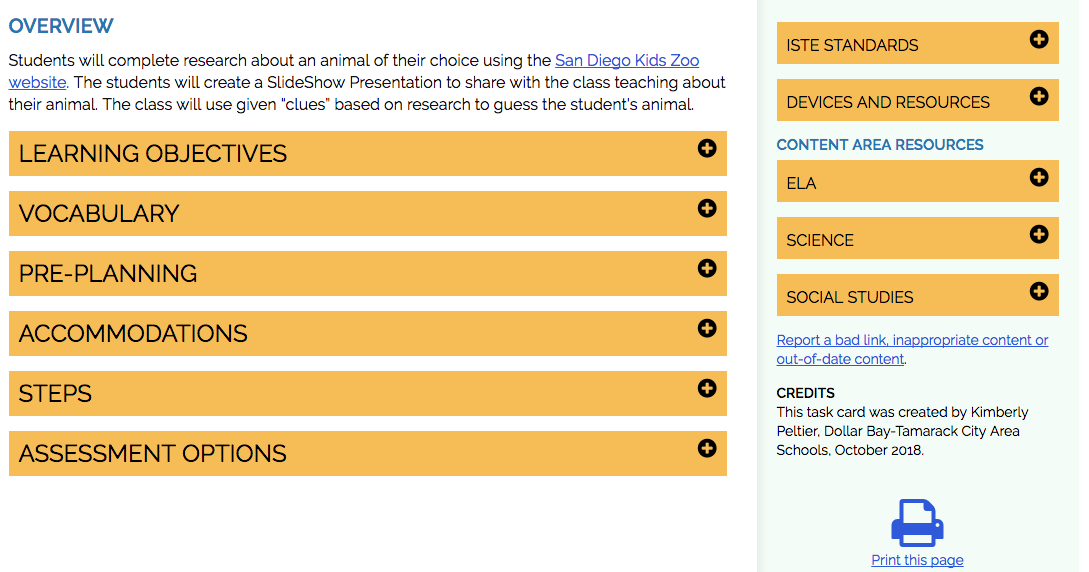What is a task Card?

The primary audience of the MiTechKid's website is K-5 educators.
It is comprised of task cards that have been assigned a grade level and competency. The cards are not limited to the assigned grade, and actually, many of them could encompass multiple competencies and grades depending on how the teacher uses the activity with the students. The cards can also easily be modified and often have extended activities so that they could be used at a lower or higher grade level.
STEPS:
1. Open up this Google Document and make a copy for yourself. (If you are taking this as a class, you will need to share the document with your instructor. ) You will fill it out as you go through this section.
2. Before you begin looking at the task cards for activities to use with your students, you should be familiar with your district scope and sequence for technology skills.
- If your district does not have an adopted one to follow you can use the scope and sequence on Michigan TechPlan.org's website.
- On the Word Document, share the link to your district scope and sequence or if not possible the one on the Michigan TechPlan website.
- If you use another one from a different district, please share that also.
3. Technology skills should be incorporated throughout the curriculum and should not be taught in insolation in the computer lab.
- If your school does not have a computer class at the elementary level, the task cards will provide activities across the content areas that have technology embedded.
- If your school does have a computer class, the instructor should be working with the grade level teachers to teach lessons that enhance the learning going on in the classroom. The task cards will assist in giving ideas for this integration.
4. Open up the MiTechKids' website.
- Note the grade levels and choose your grade level
- Choose the competency you would like to work on with your students.
- Choose a task card/s to look at to see it's structure.
5. Every task card is developed on the same template. Every task card has the following:
- Learning Objectives: You identify what you want students to know, understand, and be able to do.
- Vocabulary: You will include a list of vocabulary and definitions that will be introduced to students during this activity.
- Pre-planning suggestions: This is a list of all of the steps the teacher might do to prepare for this lesson. This is a list of tutorials that are videos or screenshots.
- Accommodations: This is support for struggling students to meet diverse learning needs/styles.
- Steps: These are the specific steps and directions for the students, along with any videos and/or resources that may be needed.
- Assessment Options: These are options that list how the teacher will assess student mastery. (e,g., Rubrics, Google Forms, Online assessments, etc. )
- Competencies and Standards: This lists the MITECS and ISTE Standards for Students
- Device or Browser specific recommendations: This is a list of all devices and browsers that are recommended as well as all the websites and videos used during the activity.
- Content area suggestions: Brief (one-three sentences) connection between this resource and the classroom in which some or all of the following may apply:
- Connect to the learning objective
- Individual, center, or small group
- Content connections or standards
- Supporting Document
6. Go through the task card you have selected and look at each of the areas listed. (Make sure to list the task card and URL on your Google Doc.)
7. Look at several task cards that you think you may want to use with your students.
- After looking at task cards, how might you use them with your students and in what content areas? Use the Word Doc to detail how you might use them.
- How can you change something you teach every year with one of the activities you have chosen?
- If you have a chance to use with students, "Do you think the technology enhanced or impeded the learning?"
Note: For those who are taking this as a class, one of the assignment choices is to create a task card to use with your students and share with your instructor. You will use the template in step five above.
Before you begin creating your own task card, you will learn more about the available features on the MiTechKids' website.
Let's move on to MiTechKids' Features.
Standards
ADDRESSING THE ISTE STANDARDS FOR EDUCATORS
Learner
1a. Set professional learning goals to explore and apply pedagogical approaches made possible by technology and reflect on their effectiveness.
1c. Stay current with research that supports improved student learning outcomes, including findings from the learning sciences.
Leader
2b. Advocate for equitable access to educational technology, digital content and learning opportunities to meet the diverse needs of all students.
2c. Model for colleagues the identification, exploration, evaluation, curation and adoption of new digital resources and tools for learning.
Designer
5a. Use technology to create, adapt and personalize learning experiences that foster independent learning and accommodate learner differences and needs.
5b. Design authentic learning activities that align with content area standards and use digital tools and resources to maximize active, deep learning.
5c. Explore and apply instructional design principles to create innovative digital learning environments that engage and support learning.
Facilitator
6c. Create learning opportunities that challenge students to use a design process and computational thinking to innovate and solve problems.
Analyst
7a. Provide alternative ways for students to demonstrate competency and reflect on their learning using technology.
